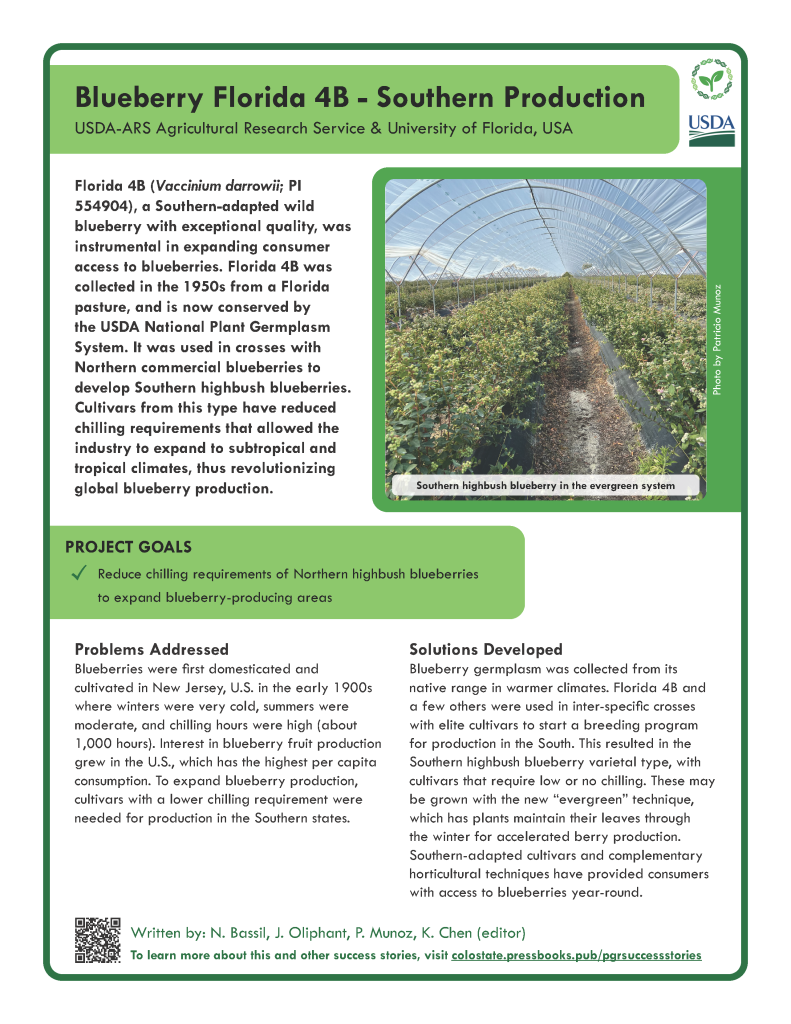Fruits and Nuts
Blueberry Florida 4B – Southern Production
FLORIDA 4B: A NATIVE PLANT THAT DEVELOPED A THRIVING SOUTHERN BLUEBERRY INDUSTRY AND HELPED EXPAND GLOBAL PRODUCTION
Nahla V. Bassil; Jim Oliphant; and Patricio Munoz
USDA-ARS National Clonal Germplasm Repository, 33447 Peoria Rd, Corvallis, Oregon 97333.
Horticultural Sciences Department, University of Florida, 2550 Hull Rd, Gainesville, Florida 32611.
Corresponding author: nahla.bassil@usda.gov
OUTLINE
- Summary
- Problems addressed
- Solutions developed
- Impact
- Germplasm
- Additional resources
- Chapter information
1. SUMMARY

Florida 4B (Vaccinium darrowii; PI 554904) is a wild blueberry with exceptional quality. It was originally collected in a Florida pasture adjacent to the road in the 1950’s, and is now conserved by the USDA National Plant Germplasm System. Florida 4B was utilized in crosses with Northern commercial blueberries and allowed the development of a Southern blueberry in Florida that rapidly expanded into all Southern U.S. states. Using Florida 4B and a few others, breeders have now reduced chilling requirement of new cultivars from 1,000 to 0 hours. This has allowed the expansion of the industry to subtropical and tropical climates. Nowadays, blueberries are also grown in Central America, southern Spain, Morocco, northern Chile, Northern Argentina, Mexico, Peru, and Ecuador. A significant volume of these blueberries are sent to the U.S., which has the highest per capita consumption. Blueberries are now available year-round, all thanks to the native plant Florida 4B.
The goal was to reduce chilling requirements of Northern highbush blueberries to expand blueberry-producing areas.
Download a printable fact sheet by clicking the image below.
2. PROBLEMS ADDRESSED

Blueberries were first domesticated and cultivated in New Jersey, U.S. in the early 1900’s where winters were very cold, summers were moderate, and chilling hours were high (about 1,000 hours). Interest in blueberry fruit production grew in the U.S. and cultivars with a lower chilling requirement were needed for production in the Southern U.S.
3. SOLUTIONS DEVELOPED
Blueberry germplasm was collected from its native range in warmer climates, like Florida. This was used in inter-specific crosses with elite cultivars to start a breeding program for production in the South. The new varietal type—Southern highbush blueberry (SHB)—has resulted in cultivars that are well adapted to low- or no-chill and are being widely planted in warm areas in the South. The SHB varietal type can be produced in the traditional system, “deciduous,” but also under the new horticultural technique called “evergreen”. Under the evergreen production technique, the plants maintain their leaves through the winter, allowing accelerated berry production. This technique can be used in the southern part of Florida or northern locations using protected high-tunnels. Consumers now have access to blueberry fruit year-round.
Collaborators involved in developing solution:
- Ralph Sharpe and Wayne Sherman, University of Florida, Gainesville, Florida, USA
- George M. Darrow, USDA-ARS Beltsville Agricultural Research Center, Beltsville, Maryland, USA
4. IMPACT

In 2021, the U.S. commercial blueberry industry value of utilized production reached $1.1 billion from 774.1 million pounds of blueberries harvested on 102,400 acres, and led the world in total volume of blueberry production.
5. GERMPLASM

The USDA National Plant Germplasm System conserves Florida 4B (PI 554904), a genebank accession responsible for a wide array of Southern-adapted blueberry cultivars.
More information can be found at GRIN-Global: PI 554904.
6. ADDITIONAL RESOURCES
Draper A, Hancock J. 2003. Florida 4B: Native blueberry with exceptional breeding value. Journal of the American Pomological Society 57:138-141.
Hummer KE, Postman J. 2020. Guardians of the germplasm: hazelnuts, berries, pears, hops and mint. Journal of the American Pomological Society 74:104-110.
7. CHAPTER INFORMATION
Citation: Bassil N, Oliphant J, Munoz P. 2023. Blueberry Florida 4B – Southern Production. In: Volk GM, Chen K, Byrne P (Eds.) Plant Genetic Resources: Success Stories. Fort Collins, Colorado: Colorado State University. Date accessed. Available from https://colostate.pressbooks.pub/pgrsuccessstories/chapter/blueberry-florida-4b-southern-production/
Content originally submitted: April 19, 2023
Date of publication: July 2023
USDA is an equal opportunity provider, employer, and lender. Mention of trade names or commercial products in this article is solely for the purpose of providing specific information and does not imply recommendation or endorsement by the U.S. Department of Agriculture.


